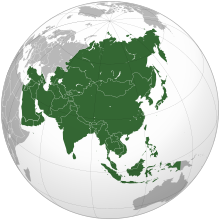| Part of a series on |
| Culture of Asia |
|---|

Asian cuisine encompasses several significant regional cooking styles of Asia: Central Asian, East Asian, North Asian, South Asian, Southeast Asian, and West Asian. Cuisine is a distinctive way of cooking practices and customs,[1] usually associated with a specific culture. Asia, as the largest and most populous continent, is home to many cultures, each with its own characteristic cuisine. Asian cuisine, also known as Eastern cuisine, is considered the "culture of food within a society" due to the beliefs, cooking methods, and the specific ingredients used throughout the entire process.[2] Asian cuisines are also renowned for their spices. A key taste factor in Asian cuisine is “umami” flavor, a strong savoriness prominent in Asian cooking, which can be achieved through fermented food or meat extract.[3]
Ingredients common to many cultures in East and Southeast Asia include rice, ginger, garlic, sesame seeds, chilis, dried onions, soy, and tofu. Stir frying, steaming, and deep frying are common cooking methods.
While rice is common to most Asian cuisines, different varieties are popular in the various regions. Glutinous rice is ingrained in the culture, religious tradition and national identity of Laos.[4] Basmati rice is popular in the Indian subcontinent, jasmine rice is often found across Southeast Asia, while long-grain rice is popular in China and short-grain in Japan and Korea.[5]
Curry is a common dish in South Asia, Southeast Asia, and East Asia. Curry dishes have their origins in the Indian subcontinent. Countries in Indochina typically use a coconut milk base in their curries; countries in Southwest Asia typically use a yogurt base.[6]
- ^ "Cuisine." Archived April 26, 2013, at the Wayback Machine Thefreedictionary.com Archived August 13, 2018, at the Wayback Machine. Accessed June 2011.
- ^ "Executive summary of "Practising conviviality: social uses of ethnic cuisine in an Asian multicultural environment"". Journal of Consumer Marketing. 32 (7). January 1, 2015. doi:10.1108/JCM-11-2015-054. ISSN 0736-3761.
- ^ Hajeb, P.; Jinap, S. (May 12, 2015). "Umami Taste Components and Their Sources in Asian Foods". Critical Reviews in Food Science and Nutrition. 55 (6): 778–791. doi:10.1080/10408398.2012.678422. ISSN 1040-8398. PMID 24915349.
- ^ Sattaka, Patcha (December 27, 2016). "Geographical Distribution of Glutinous Rice in the Greater Mekong Sub-region". Journal of Mekong Societies. 12 (3): 27–48. ISSN 2697-6056. Archived from the original on November 8, 2021. Retrieved June 11, 2021.
- ^ "The flavors of Asia". Quaker Oats Company. Archived from the original on June 4, 2007. Retrieved December 19, 2008.
- ^ "Cuisine Areas Of Asia". Kraft Foods (Australia). 2007. Archived from the original on February 25, 2011. Retrieved December 20, 2008.